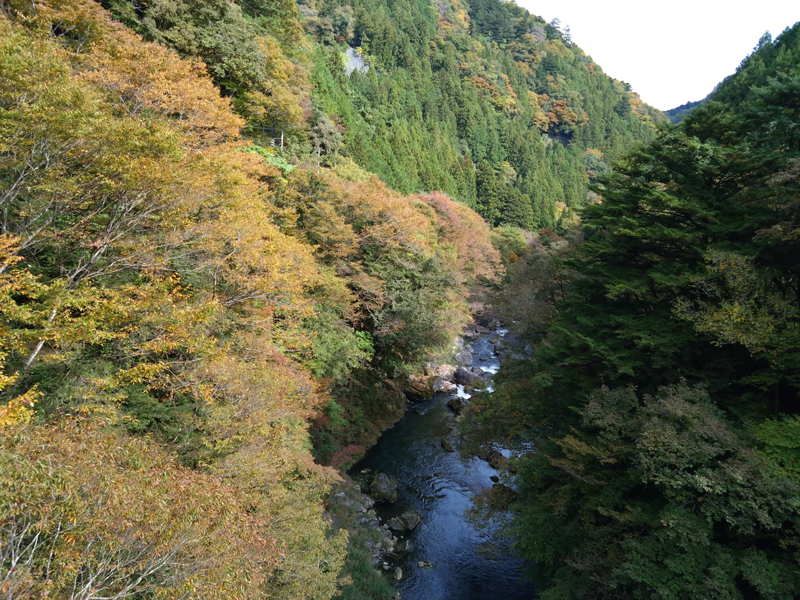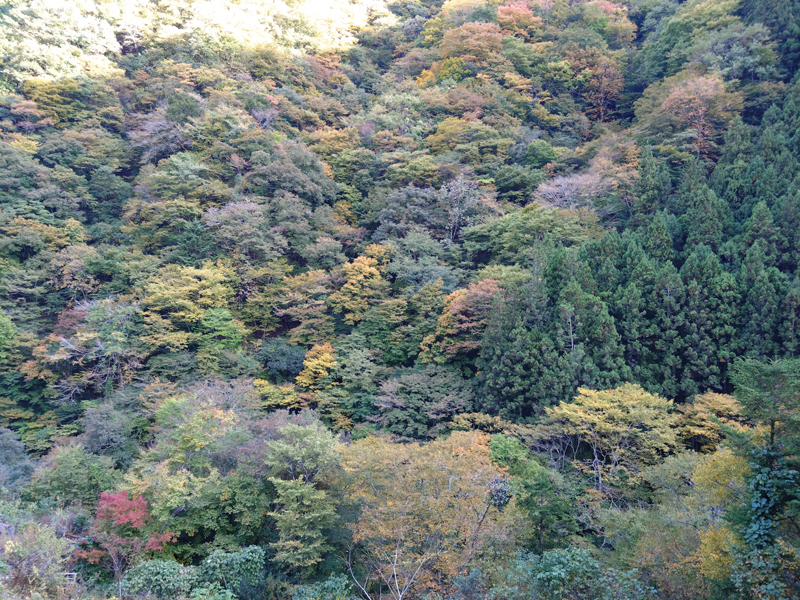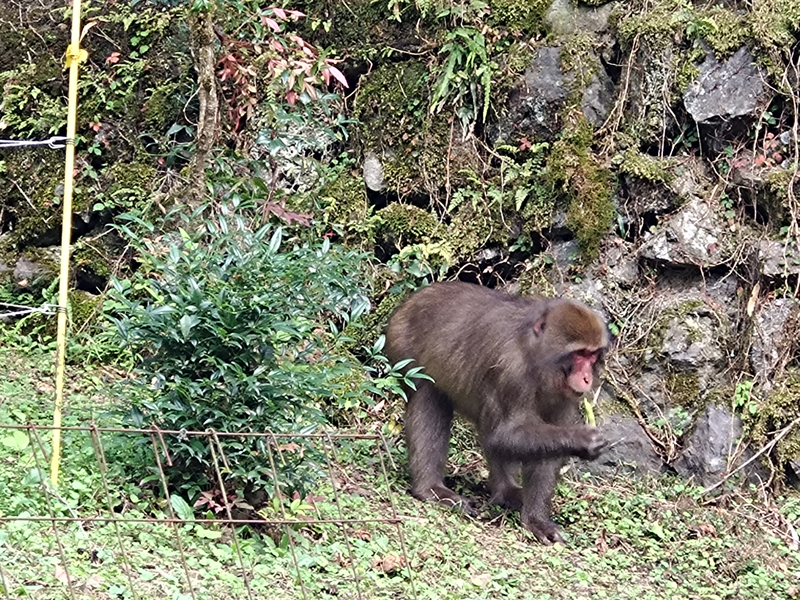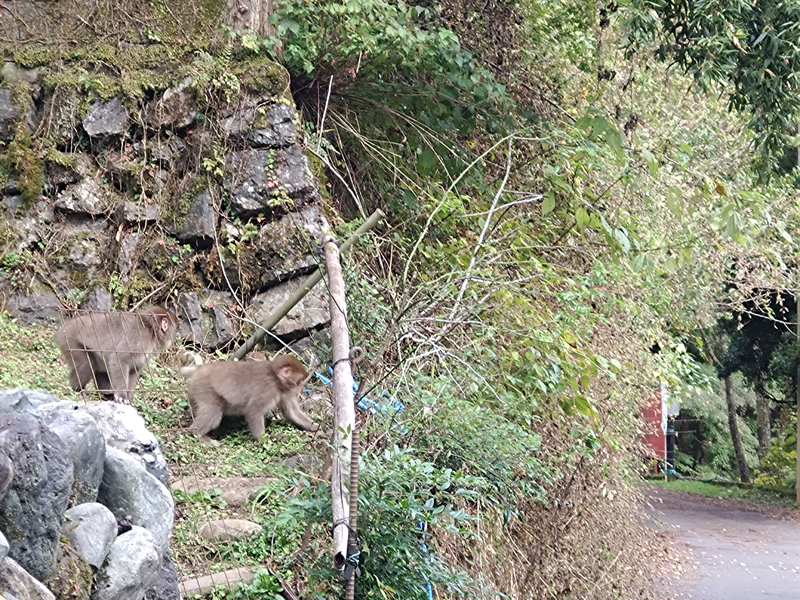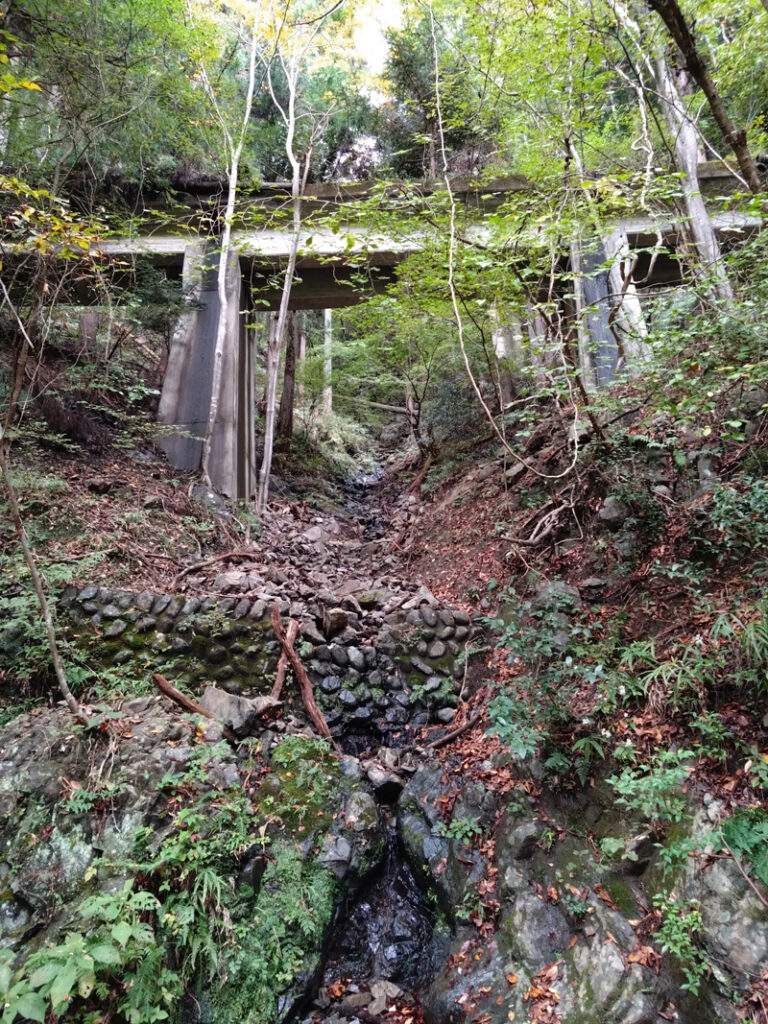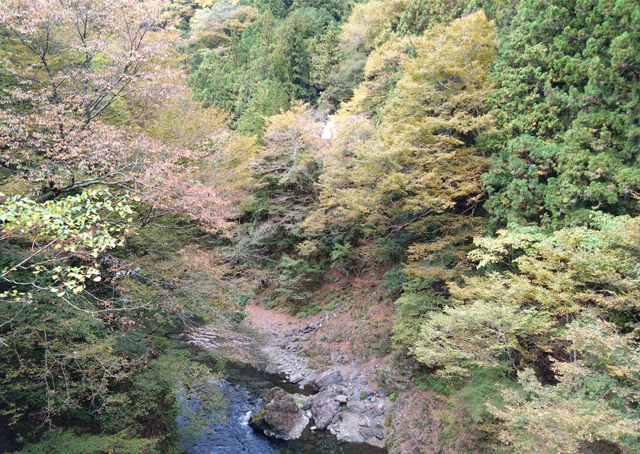
In the popular imagination, Tokyo is usually represented by the tall buildings and bright lights of Shinjuku or Shibuya, but this metropolis actually encompasses a large geographic area that includes multiple municipalities besides the urban wards. Among them, probably the most remote is Okutama, a town with a population of only a few thousand people located over fifty kilometers from central Tokyo. It was here that I headed on a recent autumn weekend to hike the Okutama Mukashi Michi or “Old Trail,” a charming route through the countryside where you can experience a very different side of Tokyo—and even meet some of its “wilder” residents…
The Okutama Mukashi Michi Trail is slightly under ten kilometers in total length, connecting a trailhead located near JR Okutama Station with the shore of Lake Okutamako, a reservoir created by a dam. Since a regular bus service also operates between the station and the lake, most visitors walk in just one direction and use the bus for either the outbound or return trip, although I walked both. The trail is not overly strenuous but does contain some steep uphill sections when going in the direction of the lake, which is at a higher elevation than the station area. It is very clearly marked with signposts and banners and also follows mostly paved roads, with a few more rugged sections.
Along the trail, visitors will encounter a variety of rustic sights and historical landmarks including thick forests, waterfalls, small shrines, abandoned railway tracks and tunnels, rope bridges, and farmhouses. There are even opportunities to purchase souvenirs, with some houses along the way selling fresh produce or handicrafts at unattended stands that function via the honor system.
Most of the route follows the Tama River, which is nearly unrecognizable here to those who know it as the broad waterway lined by parks and sports fields at the southern edge of central Tokyo. Near its source, the river is a pristine mountain stream, its rushing waters looking invitingly cool and clear.
The autumn season, when I visited, is the most popular time to walk the trail thanks to the beautiful fall foliage, and I encountered numerous groups of hikers including both locals and foreign tourists. In fact, one pleasure of hiking, whether in Japan or elsewhere, is the warm camaraderie of the trail. In central Tokyo, as in most other big cities around the world, talking to strangers is simply not something one does, and greeting passersby with a hearty Konnichi wa! would be unlikely to elicit any response but alarm or suspicion. In this part of Tokyo far removed from the concrete labyrinth, however, people for the most part followed the etiquette of acknowledging each other with a polite greeting and even some casual small talk. I asked a hunter lounging in the front seat of his parked truck if there were bears active in the area. “Oh, definitely, tons of them,” he replied nonchalantly. “We have bear spray!” noted my travel companion, the hunter conveying his approval with a silent thumbs up.
Fortunately, we did not encounter any bears, a topic of great concern in the news lately as Japan faces its worst-ever year for bear attacks. However, on the return trip from the lake, we spotted a troop of wild monkeys wreaking havoc on an unfortunate farmer’s vegetable patch. Previously, on the outbound journey, we’d witnessed that very farmer installing an electric fence to ward off the furry marauders, but it seemed to present little obstacle now as they ravaged the field, with the farmer nowhere in sight. Although undoubtedly a great source of consternation to the farmer, the antics of the nearly ten-member troop, including several baby monkeys, were adorable to watch. Equally amusing was the realization that these monkeys were, technically speaking, residents of Tokyo Metropolis just as much as a Shinjuku salaryman!
Although the leaves had just barely started to change color when I visited at the end of October, the trailside scenery must surely be even more beautiful these days, and provided that you own a sturdy pair of walking shoes, the Okutama Mukashi Michi Trail is the perfect weekend getaway to discover a very different side of this fascinating city.
(日本語訳)
東京の自然豊かな一面:奥多摩むかし道を歩く
一般に東京といえば、新宿や渋谷の高層ビルやネオンを思い浮かべるが、実際には都心部以外にも複数の自治体を含む広大な地域をカバーしている。その中で最も辺境の地と言えるのが奥多摩だ。人口わずか数千人のこの町は、東京中心部から50キロ以上離れた場所にある。この秋のある週末、私は「奥多摩むかし道」をハイキングするため奥多摩へ向かった。田舎の風景が広がる魅力的なルートで、東京のまったく異なる一面を体験できる――そして時には「野生」の住人にも出会えるのだ…
奥多摩むかし道の全長は10キロ弱。JR奥多摩駅近くの登山口から、ダムによって造られた貯水池である奥多摩湖の湖岸までを結んでいる。駅と湖の間は定期バスも運行しているため、多くの訪問者は片道だけ歩き、行きか帰りのどちらかはバスを利用する。ただし私は往復路とも歩いた。道はそれほどきつくはないが、駅周辺よりも標高の高い湖方面へ向かう際には急な上り坂がいくつかある。道しるべや標示などで非常にわかりやすくなっており、でこぼこした区間も少しはあるが舗装道路が大部分を占める。
道中には、鬱蒼とした森、滝、小さな神社、廃線となった線路やトンネル、吊り橋、農家など、素朴な風景や歴史的建造物が点在する。道沿いの家屋では、信頼で成り立っている無人の販売所で、新鮮な農産物や工芸品を購入できる機会もある。
ルートの大半は多摩川に沿って進む。都内南部で公園や運動場に囲まれた広大な河川として知られる多摩川と、同じ川とは思えないほど様子が異なる。源流付近の川は清らかな山の渓流で、勢いよく流れる水は魅力的に涼やかで透き通っている。
私が訪れた秋の季節は紅葉が美しく、この遊歩道を歩くのに最も人気のある時期だ。地元の人々や外国人観光客を含む多くのグループに出会った。実際、日本であろうと他の国であろうと、ハイキングの楽しみの一つは、道中で感じる温かい仲間意識である。東京の中心部では、世界の他の大都市と同様、見知らぬ人と話すことはまずなく、通りすがりに元気よく「こんにちは!」と声をかけても、驚いたり疑わしいと思われたりするだけで、返事は期待できない。しかし、コンクリートの迷宮から遠く離れたこの東京の片隅では、人々は概ね、互いに丁寧な挨拶をしたり、時には気軽な世間話を交わしたりしていた。駐車したトラックの運転席でくつろぐ猟師に、この辺りに熊はいるかと尋ねた。「ああ、間違いなく山ほどいるよ」と彼は気さくに答えた。「熊よけスプレーを持っています!」と同行者が言うと、猟師は黙って親指を立てた。
幸い、私たちは熊に遭遇しなかった。最近ニュースで大きく取り上げられている話題だ。日本は熊による襲撃が過去最悪の年を迎えている。しかし帰り道、湖から戻る途中、野生の猿の一団が不運な農家の野菜畑を荒らしているのを目撃した。行き道では、まさにその畑の農夫が毛むくじゃらの略奪者たちを防ぐために電気柵を設置しているのを目撃していたが、今やそれはほとんど障害になっていないようだった。猿たちは畑を荒らし回っており、農夫の姿はどこにも見当たらなかった。農夫にとっては間違いなく大きな悩みの種だろうが、数匹の子猿を含む十匹近い猿の群れの様子は愛らしく、厳密に言えば、これらの猿たちもまた新宿のサラリーマンと同じく東京都の住民だという事実に気づいたのもまた愉快だった。
10月末に訪れた時は葉が色づき始めたばかりだったが、今頃は道沿いの景色がさらに美しくなっているに違いない。しっかりしたウォーキングシューズさえあれば、奥多摩むかし道は週末の小旅行に最適で、この魅力的な都市のまったく異なる一面を発見できるはずだ。
最後まで記事をご覧いただき、ありがとうございます。
株式会社イデア・インスティテュートでは、世界各国語(80カ国語以上)の翻訳、編集を中心に
企画・デザイン、通訳等の業務を行っています。
翻訳のご依頼、お問わせはフォームよりお願いいたします。
お急ぎの場合は03-3446-8660までご連絡ください。

